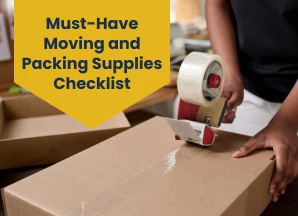Tips for Moving to Temporary Housing

Are you preparing to move into temporary housing? Well, moving to a temporary living arrangement is surely different from settling into a permanent home, and it requires thoughtful planning to make the most of your stay. Relocating for work, waiting for a new home to be ready, or transitioning between properties often involves temporary housing.
Let’s explore the essential tips for managing your move smoothly and making the most of your time in temporary housing.
What is a Temporary House?
A temporary house is a place where you’ll stay for a limited period. This might be an apartment, a short-term rental, a corporate housing unit, or even a vacation home. Unlike a permanent residence, temporary housing is designed to be a flexible solution for people in between moves, on business trips, or undergoing home renovations.
Before packing, it’s important to get clarity on the specifics of your temporary living arrangement. Ask yourself questions like:
- Will the place come fully furnished or will I need to bring my own furniture?
- How long will I stay, and will that affect the amount of stuff I bring with me?
- Are utilities, internet, and cable included, or will I need to set them up?
Understanding these details will help you plan better and avoid bringing unnecessary items. Let’s explore some practical tips to help you navigate your move and settle into your temporary home with ease.
1. Create a Packing Strategy for Your Temporary Stay
When moving to temporary housing, packing can be a bit tricky. You don’t want to overpack since it’s only for a limited time, but you also want to ensure you have everything you need for comfort. A good packing strategy is essential.
Start by creating an apartment packing list that includes only the essentials. Focus on what you use every day and what will help you feel settled during your stay. This includes:
- Clothing: Pack clothes that suit the weather and your lifestyle. Think of versatile outfits that can be worn multiple times.
- Toiletries: Include shampoo, soap, toothpaste, and all personal hygiene items you use daily.
- Bedding: If your temporary housing isn’t fully furnished, pack your own sheets, pillows, and comforter.
- Kitchen items: If your space doesn’t come with kitchenware, consider bringing basic items like a pot, a few dishes, utensils, and a coffee maker.
- Electronics: Don’t forget your laptop, phone, chargers, and any other necessary gadgets you use for work or entertainment.
2. Keep It Simple
When moving to temporary housing for a short period, like a month or two, you don’t need to pack your entire home. Instead, focus on how to pack efficiently for the short term. Think about what you'll realistically need during your stay and how to avoid clutter.
If you’re wondering how to pack for a move in a month, here are a few tips:
- Limit your clothing: Only pack what you’ll need for the season, and avoid overloading on extra outfits.
- Use storage bins or suitcases: These are good for organizing your belongings and making everything easier to transport and store.
- Keep seasonal items in storage: If you’re only staying for a short time, leave any out-of-season clothing, equipment, or decor in storage to avoid cluttering your temporary living space.
- Pack a small box of essentials: Include things like important documents, a first-aid kit, your phone charger, and any medications you may need.
By taking only the necessities, you'll avoid feeling cramped in a small space and make it easier to settle into your temporary home.
TIP: If you’re looking to make your move stress-free and efficient, choosing the right moving company is crucial. At Van Lines Move, we offer a wide range of moving services to fit your needs, whether you’re moving locally, long-distance, or even across the country. Our experienced team ensures that your belongings are safely transported with care and precision, no matter the distance. From packing and unpacking to secure storage solutions, we provide flexible, affordable services that make your move smooth and hassle-free. Contact us today!
3. Organize for Quick Access to Your Essentials
In temporary housing, you won’t have the luxury of endless storage space or the ability to leave things scattered around. It’s important to organize your belongings in a way that makes it easy to access the things you use the most.
Consider:
- Labeling your boxes: This will help you find things quickly and avoid searching through several boxes to locate a single item.
- Using multi-purpose furniture:If your temporary living arrangement doesn’t come with much furniture, consider packing lightweight, multi-purpose items such as a folding table or a storage ottoman. These pieces are functional and easy to store when you leave.
- Creating a daily essentials bag:Pack a bag with your daily necessities like toiletries, phone, laptop, keys, and a few clothes. Keep this with you during the move, so you don’t have to unpack everything immediately.
4. Adapt to Your New Environment Quickly
Temporary stays can feel disorienting at first, but creating a routine will help you settle in faster. It’s essential to adapt to the new space and surroundings. Here are a few ideas to help you get comfortable in your temporary home:
- Personalize your space: Even though it’s short-term, adding a few items that feel like home - such as family photos, candles, or plants - can make the place more inviting.
- Learn the area:Take time to explore your neighborhood, find local stores, coffee shops, and restaurants. This will make the temporary living arrangement feel less like a hotel and more like a part of your daily life.
- Set up your technology:Set up internet, streaming services, and work-related equipment right away. This will help you feel connected and settled during your stay.
5. Consider Your Budget for a Temporary Stay
Temporary housing arrangements can vary widely in cost, and it’s important to budget accordingly. Take the time to calculate what you can afford for the duration of your stay. Be aware of any hidden fees for utilities, deposits, or cleaning services, and keep track of your spending.
If you’re on a tight budget, consider finding short-term housing options that provide the basic amenities you need. Look for deals or discounted rates, especially if you’re staying for a month or longer.
Related Articles:
- Summer Moving Tips for Long-Distance Move
- Tips to Avoid Last-Minute Moving Cost
- Tips To Make Your Move Safe And Secure
6. Plan for the End of Your Temporary Stay
Once you’ve moved in, it’s easy to forget that your stay will eventually end. Make sure you have a plan for when it’s time to move out. Take note of the end date of your temporary housing and start planning for your next move well in advance. This might include:
- Giving notice: If you're renting, be sure to follow any required notice periods.
- Moving out essentials:Keep track of how to return the apartment in good condition, including any cleaning or maintenance duties.
- Arranging your next home:Whether you’re moving to a permanent home or another temporary space, start looking into your next move early.
Moving into temporary housing offers flexibility and convenience, but it can also come with unique challenges. With careful planning, organization, and an understanding of your temporary living arrangements, you can ensure that your time in temporary housing is comfortable and stress-free.
By packing efficiently, adjusting quickly, and managing your budget, you’ll create a positive experience during your temporary stay, making the most of this in-between chapter in your life.
Categories
- Long Distance Moving145
- Local Moving116
- Commercial Moving38
- Residential Moving30
- Last – Minute Moving25
- Furniture Moving8
- Moving Cost Calculator5
- Piano Moving3
- Car Transportation3
- Truck Rental3
- Moving Cost3
- Local Move3
- best moving rates3
- cheap moving companies3
- affordable moving companies3
- Junk Removal2
- Senior Moving2
- Senior Relocation Moving Companies2
- Moving Tools2
- Moving Estimates2
- Moving companies2
- Moving services2
- state to state movers2
- Heavy Equipment1
- Moving Container1
- Senior Moving Services1
- moving tips1
- office moving1
- office relocation1
- employee relocation1
- Car Transport1
- Vehicle Shipping1
- Car Shipping Services1
- Artificial Intelligence1
- Office Moving Services1
- Commercial Moving Companies1
- Corporate Moving Services1
- Corporate Movers1
- interstate moving1
- full-service movers1
- full-service moving companies1

 Local Movers
Local Movers Last-Minute Movers
Last-Minute Movers Junk Removal
Junk Removal Long Distance Movers
Long Distance Movers Piano Movers
Piano Movers Heavy Equipment
Heavy Equipment Commercial Movers
Commercial Movers Moving Container
Moving Container Car Transportation
Car Transportation Furniture Movers
Furniture Movers Truck Rental
Truck Rental Moving Cost Calculator
Moving Cost Calculator Moving Planner
Moving Planner Packing Calculator
Packing Calculator Moving Checklist
Moving Checklist Moving Insurance
Moving Insurance FAQ
FAQ Contact Us
Contact Us Moving Loan
Moving Loan About Us
About Us








